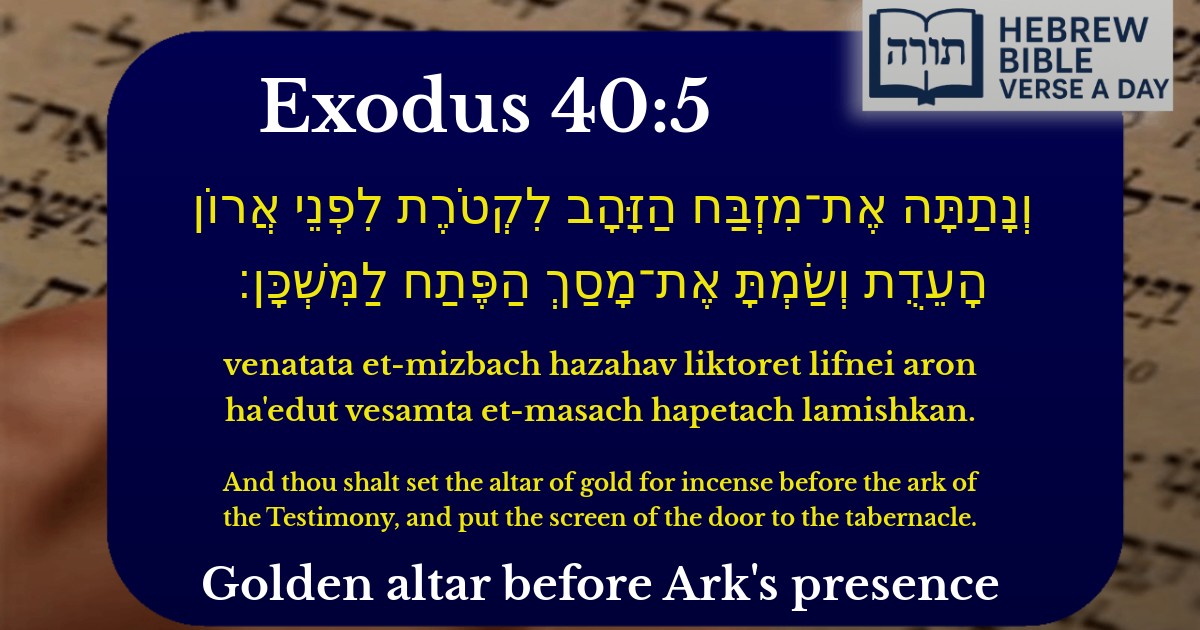Frequently Asked Questions
Q: What is the 'altar of gold for incense' mentioned in Exodus 40:5?
A: The 'altar of gold for incense' (מִזְבַּח הַזָּהָב) refers to the small golden altar used in the Mishkan (Tabernacle) for burning ketoret (incense). According to Rashi, this altar was placed inside the Holy Place, before the Parochet (curtain) that separated it from the Holy of Holies where the Ark of the Testimony stood. The incense offering was a daily ritual performed by the Kohanim (priests).
Q: Why was the incense altar placed before the Ark of the Testimony?
A: The incense altar was placed before the Ark of the Testimony to symbolize that our prayers (represented by the rising smoke of the incense) should be directed toward Hashem's presence, which rested above the Ark. The Talmud (Yoma 44a) explains that the incense atoned for lashon hara (evil speech) and fostered unity, just as its smoke rose upward as one cohesive column.
Q: What is the significance of the 'screen of the door' in Exodus 40:5?
A: The 'screen of the door' (מָסַךְ הַפֶּתַח) was a curtain at the entrance of the Mishkan, serving as a separation between the holy space and the outside. Rambam (Hilchot Beit HaBechirah) explains that such boundaries teach us the importance of approaching kedushah (holiness) with proper preparation and reverence. Just as the Kohanim couldn't enter casually, we too must approach spiritual matters with mindfulness.
Q: How does the incense altar relate to Jewish practice today?
A: Although we no longer have the Mishkan or Temple, the ketoret (incense) service is remembered in our prayers. The daily recitation of the Ketoret passage (found in Siddurim) connects us to this mitzvah. The Midrash (Tanchuma Tetzaveh 15) also teaches that the incense represents the 'hidden' mitzvot—those done quietly, like charity without publicity—which are especially beloved by Hashem.
Q: Why was the altar made of gold specifically?
A: Gold symbolizes the highest level of spiritual purity and value. Rashi (on Exodus 30:3) notes that the gold covering the altar reflected the inner holiness of the Mishkan's service. The Ramban adds that gold, which doesn't tarnish, represents the eternal nature of the bond between Hashem and the Jewish people, as well as the enduring power of sincere prayer offered at this altar.


Placement of the Golden Altar
The verse (Exodus 30:6) commands placing the golden altar for incense "before the ark of the Testimony." Rashi explains that this does not mean directly in front of the ark, but rather in line with it - the altar stood midway between the ark and the table of showbread, slightly toward the north (Rashi on Exodus 30:6). The Rambam elaborates in Hilchot Beit HaBechirah (3:12) that the golden altar was positioned in the inner sanctuary, but outside the parochet (veil) that separated the Holy of Holies.
Purpose of the Golden Altar
The Talmud (Zevachim 59a) teaches that the golden altar served to atone for lashon hara (evil speech), as the incense's ascent symbolizes how speech rises. The Midrash Tanchuma (Tetzaveh 15) connects this to the verse in Proverbs (16:24) - "Pleasant words are like a honeycomb," suggesting that the sweet-smelling incense represents the power of proper speech.
The Screen at the Tabernacle Entrance
Regarding the screen for the tabernacle entrance, Rashi (on Exodus 26:36) notes it was woven with the same four materials as the inner curtains but with additional embroidery. The Talmud (Yoma 54a) discusses how this screen served as a separation between the sacred space and the outside world, teaching that proper boundaries are essential in serving Hashem.
Spiritual Significance